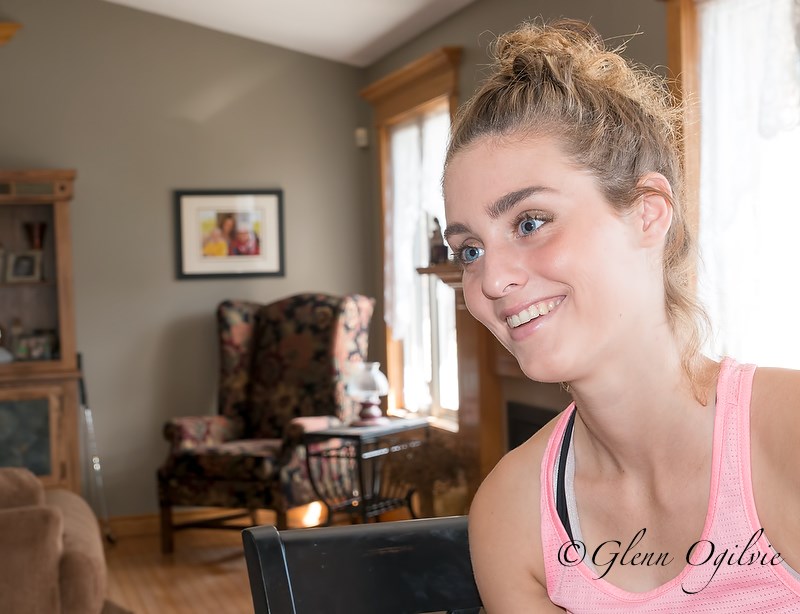Cathy Dobson
Hannah Earle doesn’t want to hide her eating disorder anymore.
“I want other girls to know you don’t need to be ashamed and that it is possible to recover,” said the 17-year-old. “We live in a society where women have to look and act a certain way, and it’s so wrong.
“I’m going to use my experience to help others.”
It’s been two years since the urge to lose weight took over Hannah’s life. She was an accomplished athlete in Grade 9, already playing for her high school’s senior basketball team.
It wasn’t a single event that triggered her anorexia nervosa, she said.
“They call it a perfect storm. I was always taller, always the biggest kid in the class, and I was called fat in Grade 2.”
As she got older, Hannah said her curves attracted unwanted attention and made her feel ashamed. When her parents took their athletic daughter to a trainer at age 15, he remarked on how muscular she was.
“He said I’d never be a runway model because I had these muscular legs. That was it. I decided to get skinny.”
In just three months, she lost 50 pounds, primarily by counting calories with a phone app and refusing to eat almost anything but fruit and vegetables.
“Hannah has never been overweight,” said her mom, Terri-lyn Earle. “She’s the last person you’d expect this to hit. She’s an achiever; she’s beautiful.
“But it didn’t matter. For her, fitness became a powerful obsession and she was able to convince the people closest to her that nothing was wrong.”
Ultimately, Hannah couldn’t hide it.
Her weight dropped so drastically that she began passing out. Her blood pressure was dangerously low and she developed heart palpitations.
“I was losing my hair, my grades were falling and I was kicked off the basketball team because I had no energy,” she said.
“This disease is an addiction. I went from being a bubbly, outgoing person who loves everyone to someone who was so selfish and so alone.
“The only thing that made me feel good was when I got on the scale and saw I was losing. Nothing else mattered.”
One day, she fainted and was scared enough to call her parents who took her to the hospital. At nearly 5’ 11”, she weighed only 110 pounds.
Hannah was diagnosed with an eating disorder and sent to a local dietician and counsellor.
“But I didn’t want to go. I told my parents I would do this on my own, when in reality I still wanted to lose weight.”
Literally overnight Hannah switched from depriving herself of food to binging on everything in sight, then purging.
“I went home and was so hungry, I couldn’t stop eating. Then I was disgusted with myself and felt so guilty, I needed to get it out of me and I went into the bathroom and purged.
“That’s when I realized I could eat without gaining weight. It’s difficult for people to understand because it’s not rational.
“I was a slave to this. It had control over me.”
Her mother knows she came very close to losing her daughter.
“I said to her 100 times, you are not going to die on my watch,” said Terri-lyn. “It’s very difficult, but I finally learned I can’t fix it. I had to back off.”
Hannah was admitted into an eating disorders program in London where she stayed for seven months, but showed no improvement.
It wasn’t until she was accepted into a new program that Hannah began to heal. Ontario Shores Centre for Mental Health Sciences opened a small eating disorders unit in Whitby last year.
“There are only 12 beds and I got the 12th one in December,” said Hannah. “Going there saved my life.”
She admits she was still purging for several weeks when she arrived, but soon learned that she was the only one who could beat her eating disorder.
“I began to see the damage I had done and I realized I needed to fix this,” she said. “So I stopped and I found things outside of my eating disorder that made me enjoy life again.”
Eight months later, Hannah is preparing to come home and hopes to return to school in Sarnia next month.
She’s eating normally now and her body is recovering.
“There are still things I struggle with but I’m at a point where I can start to get my life back. I’m so ready.”
Speaking out about her eating disorder has prompted others to talk to her about it.
“I know at least 10 other girls in Sarnia who are struggling,” Hannah said. “It’s not easy. It’s a battlefield but it’s possible to get better.
“Talk to someone you trust. It’s so worth it.”
DID YOU KNOW:
-The most common age of onset for eating disorders is between 14 and 25 and the ratio of women to men affected is nine to one.
- There are between 600,000 and 990,000 people suffering from eating disorders in Canada. In Ontario, about 32,400 young people are affected. As many as 10% with anorexia die from health problems or suicide.
Source: Canadian Mental Health Association
